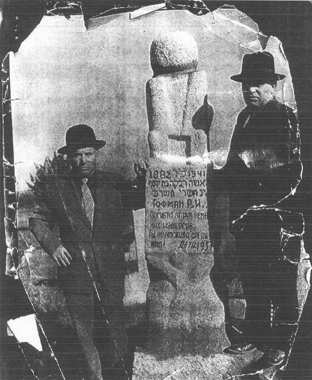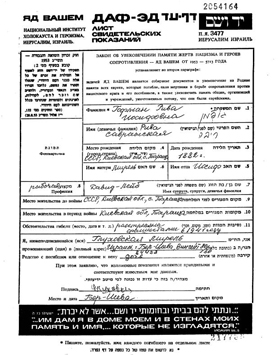by Richard L. Baum
When my mother came to America in the late 1920s, many of her cousins, aunts, and uncles remained behind in her hometown of Tarashcha, located about one-hundred kilometers south of Kiev, the capital of the Ukraine.
After World War II, in the late 1940s, my mother received a letter from a distant relative who was then living in Moscow. This elderly relative stated that she was the only family member who had survived — all the others had been killed. For the rest of my mother’s life, more than fifty years, until her death in 1999, she accepted this declaration with great sadness. She often reminisced about her wonderful and large family that was no more.
During those post-war years, while I was growing up in The Bronx, my mother enthralled me with stories about her life in Tarashcha — stories tinged with both nostalgia and foreboding. It was this exposure to my mother’s memories that somehow drew me to learn as much as I could about her family.
Most of my research has been based on American records of those members of the Sevransky (my mother Celia’s maiden name) and related families who came to America before World War II. I did, however, obtain some Russian records from Tarashcha; none of these documents are Holocaust-related.
I avoided Holocaust research because I accepted my mother’s belief that when the Germans swept through the region in 1941 all of her Ukrainian relatives had been murdered and buried in anonymous mass graves by the Germans and their Ukrainian minions. What was there to research? The Germans made a point of not recording the names and circumstances surrounding the murder of their victims. Everything the Nazis did was masked by using euphemisms and number counts in the progress reports sent back to Germany.
I do not have a clear recollection as to when I first learned of Yad Vashem and its Pages of Testimony. Thinking of it now, as I write this essay, it may have been in the early 1990s from an article in a Jewish genealogical journal. I do remember thinking at the time that it would be fruitless for me to hire someone in Israel to search for records that most likely did not exist. As it turned out, my decision was a serious blunder.
Sometime later, I became aware that Yad Vashem had placed an English language version of its Pages of Testimony on its website. In late 2007, during one of my internet searches, on a whim, I entered my mother’s surname into the Yad Vashem search engine. Sitting in front of my monitor, I was expecting a null result when I was stunned to see two Pages of Testimony “pop up.” Someone had survived. A survivor! The elderly Moscow relative had been wrong!
One of the Pages of Testimony was submitted in 1991 by a Miriam Glukhovski in memory of her mother, Riva Savranski Gofman (the other was for Miriam’s husband). Riva’s parents were listed as Yosef Savranski and his wife, Mirel, of Tarashcha, Kiev, Ukraine. Riva’s husband was David Gofman.
Riva’s biographical information matched facts my mother had told me. My mother’s great-uncle and great-aunt were Ios (Yosef) and Sura-Mirel Sevransky. Ios and Sura-Mirel had several children, one of whom, my mother had told me, was Rifka Sevransky, who had married a man from Stavishche; my mother, though, could not recall the man’s name. She did recall that Rifka’s husband had been killed in the Great War, along with my mother’s father. My mother also stated that Rifka and her husband had six children; I was guessing that Miriam Glukhovski was one of the six — it had to be so.
It was clear to me that this Page of Testimony was in memory of one of my relatives, and that Miriam Glukhovski was my mother’s second cousin. Miriam lists an additional name for herself — Sara Mirel — no doubt in conformity with the traditional Ashkenazi naming after a relative — in this case, Miriam’s grandmother and my mother’s great-aunt Sura-Mirel!
Miriam had submitted the Page of Testimony in 1991, about the time that I had decided not to pursue research into these documents. By the time I had located the Page of Testimony, it was 2007, eight years after my mother had passed away. This upset me no end because I was fairly certain that my mother and Miriam knew each other in Tarashcha. If it wasn’t for my lack of vision in searching Yad Vashem for family, my mother might have had the joy of being reunited with her cousin.
With the help of my Brooklyn cousin Elliot R., I was able to determine from the Page of Testimony that Miriam lived in Israel. I have a relative, George S., who lives in Jerusalem, and I enlisted his aid in tracking Miriam down. It wasn’t too long before my Israeli cousin found Miriam’s daughter Maria living in Ber Sheva. Sadly, Miriam had passed away in 2004. Luckily, Maria was very helpful and was able to provide information about the family.
Maria, her sister Asya, and their mother survived the war by moving eastward to Krym; anyone who remained in Tarashcha died. In 1991 Miriam and her daughters found their way to Israel. Miriam’s husband Elshaia had died in 1942 while serving in the Soviet Army. She had nieces and nephews living in Canada and in the United States. One of Miriam’s nephews, Roman S., lives about ten blocks away from me in Manhattan! I called him right away, but either he did not believe that we were related or he did not care to establish a relationship (some years later I was able to connect with Roman’s daughter). Other of Maria’s contacts were more productive — Miriam’s Boston cousin Kira led me to Stella, another cousin in Los Angeles who, in turn, has connected me to still other cousins, including those living in Germany. My relationship with Stella has been incredibly productive in researching our family; her fluency in Russian has opened many family documents to me that I would never have been aware of.
I have often wondered that if I had located Miriam Glukhovski early on, whether my mother would have easily accepted the “re-birth” of at least some of her beloved family. She had so deeply, and for so much of her long life, mourned the devastation of her large family that she might not have believed the miracle that my nonfeasance had deprived her of experiencing.
Note: Along with the Page of Testimony, Miriam also submitted a photo of her mother’s headstone, shown above. Murdered by the Nazis in Tarashcha in 1941. Flanking the monument are Riva’s sons Naum and Itshok.
May 2020
New York, New York, USA
A slightly different version of this article first appeared in Dorot, The Journal of the Jewish Genealogical Society (New York), Winter 2009-2010, volume 31, number 2. Reprint permission granted.
Research Notes and Hints
By entering his mother’s surname into the Yad Vashem Database, Richard discovered through a Page of Testimony that some family members had survived the Holocaust, contrary to what his mother had been told in the late 1940s.
With help from a Brooklyn cousin and a relative in Israel, Richard connected with living descendants of his mother’s family. Engaging other willing family members in your research can yield successful results.
For more information about Richard’s ancestral town of Tarashcha, Ukraine, see JewishGen’s Tarashcha Town Page and KehilaLinks page . Richard manages both of these pages.
For more information regarding the Holocaust, see JewishGen’s Holocaust Database. This collection of component databases contains more than 2.75 million entries about Holocaust victims and survivors.

